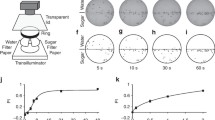Conclusions
-
1.
The reactions of command neurons of avoidance behavior to the presentation of food differ significantly between hungry and satiated snails if the hemolymph is substituted by salt solution.
-
2.
Introduction to hungry snails of the hemolymph from satiated animals significantly changes the responses of the command neurons of avoidance behavior to food, the responses becoming similar to those of neurons of satiated snails.
-
3.
The avoidance reactions to the reinforced form of food, appearing after development of the avoidance conditioned reflex to food, are similar to the avoidance reactions to food in satiated animals.
Similar content being viewed by others
Literature cited
É. A. Asratyan, Outlines of the Physiology of Conditioned Reflexes [in Russian], Nauka, Moscow (1970), p. 150.
G. N. Galanina, I. S. Zakharova, O. A. Maksimova, and P. M. Balaban, “Role of the giant serotonin-containing cell from the cerebral ganglion of the edible snail in the organization of food-procuring behavior,” Zh. Vyssh. Nervn. Deyat.,36, No. 1, 110 (1986).
O. A. Maksimova and P. M. Balaban, Neuronal Mechanisms of Plasticity of Behavior [in Russian], Nauka, Moscow (1983).
D. A. Sakharov, “Synaptic and nonsynaptic models of the neuronal system. Simple nervous systems,” Thesis, Presented at the All-Union Conference “Simple Nervous Systems and Their Significance in Theory and Practice,” Kazan (1985), Vol. 2, p. 78.
I. I. Stepanov and M. I. Lokhov, “Specificity of facilitation of development of a conditioned reflex in the edible snail by the hemolymph of a trained animal,” Dokl. Akad. Nauk SSSR,282, No. 2, 465 (1985).
V. M. Storozhuk, and I. N. Antonov, “Role of the humoral factor and postsynapticsensitization in heterosynaptic facilitation,” Neirofiziologiya,18, No. 2, 250 (1986).
R. D. Hawkins, T. W. Abrams, T. J. Carew, and E. R. Kandel, “A cellular mechanism of classical conditioning in Aplysia: activity-dependent amplification of presynaptic faciltiaton,” Science,219, No.4583, 400 (1983).
I. Kupferman and K. R. Weiss, “The command neuron concept,” Behav. Brain Sci.,1, No. 1, 3 (1978).
O. A. Maximova (Maksimova) and P. M. Balaban, “Neronal correlates of aversive learning in command neurons for avoidance behavior ofHelix lucorum L.,” Brain Res.,292, No. 2, 139 (1984).
E. T. Walters and J. H. Byrne, “Associative conditioning of single sensory neurons suggests a cellular mechanism for learning,” Science,219, No. 4583, 405 (1983).
Author information
Authors and Affiliations
Additional information
Translated from Zhurnal Vysshei Nervnoi Deyatel'nosti imeni I. P. Pavlova, Vol. 38, No. 1, pp. 146–152, January–February, 1988.
Rights and permissions
About this article
Cite this article
Balaban, P.M., Maksimova, O.A. Differences in responses of identified neurons to chemostimuli in satiated and hungry grape snails. Neurosci Behav Physiol 18, 469–474 (1988). https://doi.org/10.1007/BF01185072
Received:
Issue Date:
DOI: https://doi.org/10.1007/BF01185072




